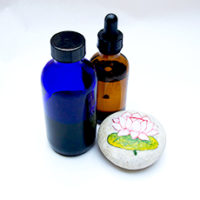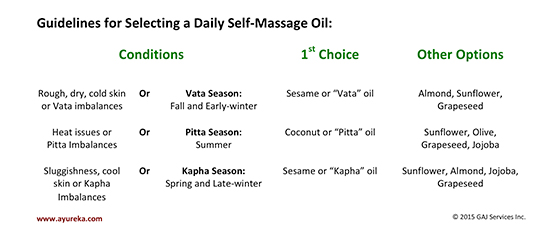Ayurvedic Self-Oil Massage
In the Ayurvedic tradition, a self-oil massage is known as an abhyanga (ah-bee-yan-ga). It is an age-old, morning practice of lubricating the body with wholesome oil. In the Ayurvedic tradition, a self-oil massage is known as an abhyanga (ah-bee-yan-ga).
In the Ayurvedic tradition, a self-oil massage is known as an abhyanga (ah-bee-yan-ga).
It is an age-old, morning practice of lubricating the body with wholesome oil.
An abhyanga—especially when using a high quality, cold pressed oil—has many significant benefits:
Nourishment: Oil nourishes your body through the skin (transdermal absorption), restoring vital nutrients.
Removing unwanted toxins: Using oil on your skin takes known toxins off of your skin. Most store-bought lotions introduce known endocrine disruptors and carcinogens into your body. (Most things placed on your skin are absorbed into your blood stream within hours.) The long-term health impact of skin-product chemicals is not known. And there is growing evidence that what they are doing to us is not pretty.
Immunity builder: Abhyanga forces lymphatic movement. Your lymphatic system is the foundation of your immunity. Unlike your blood circulatory system, you lymphatic system largely relies on body movement to keep it flowing. A self-massage is a lovely way to help your lymph flow.
Keep Vata in alignment: Oil helps to keep Vata in alignment. And since a Vata imbalance is the root of so many health issues, a daily oil massage is a key preventative practice.
Self-love: A self-oil massage is an expression of self-love. Giving yourself permission to focus exclusively on yourself for 15 minutes a day is powerful stuff on its own.
Not to mention….it just feels great!
Choosing Your Oil
Ayurveda understands that your dietary needs and daily practices change based on the season, your birth constitution and your present circumstances. Your lubrication choices may also fluctuate.
There are many types of oils. The key to staying lubricated and glowing throughout the year is reading your body’s clues. Warming oils combat the harsh dryness of winter and “ground” worries and anxieties. Cooling oils provide relief from summer’s heat, while keeping temper flare-ups in check. And invigorating oils put a spring in your step as the heavy juiciness of spring sets in.
Here are a few considerations:
- Sesame oil tends to be the “go to” oil for Ayurvedic massages. However, sesame oil can be very heating. If your body naturally runs hot, or if you are suffering from hot flashes, this oil may not be for you.
- If you’re an individual who fears oil, think about using a less viscous one. Sunflower oil might be a good option.
- Your body changes. Don’t be surprised if you find yourself wanting to explore other oil options—especially as the season transitions. It is not uncommon to massage with sesame oil in the winter, sunflower oil in the spring and coconut oil in the summer.
In Ayurveda, it is recommended that a daily self-oil massage become part of your morning health routine. It is understood that “lubing-up” regularly at night can lead to unwanted Ama.
There are exceptions to every rule. For example, if you are having difficulty sleeping, a nightly abhyanga can be your best friend.
It is important to remember that your body “drinks” through the skin. Skin is the body’s largest organ. The contents of just about any oil (or lotion) you apply to it are in your blood stream within hours. Regardless of what type of oil you choose, it should be clean and fresh. Organic and cold-pressed are two very important purchasing considerations.
A. Muzda Enterprises, Mountain Rose Herbs and Banyan Botanicals are a few of our favorite online sources for oils. If you want to avoid shipping costs as you experiment, try the organic section of your local fresh grocer. (And remember that these oils are not always cold-pressed and can vary significantly in quality).
Oil Is Not Fabric-Friendly
Below are instructions for a self-oil massage. But first, a reminder: oil is not fabric-friendly! If you are just starting out, find a couple of old towels to dedicate to the practice—ones you could stand to lose down the road as oil accumulates to the point of ruin.
As self-oil massage becomes part of your daily morning health routine, consider buying some inexpensive towels for your regimen. Along those same lines, cotton socks (preferably organic) provide an extra layer of protection for your floors. And be sure to not mix these oil-covered items with other clothing in the wash. (See the sidebar for washing instructions.)
Tips for Avoiding Oil Encroachment
Oil can cause problems for your washer/dryer and for your stuff! Here are a few tips to consider:
• Buy some “throw away” hand towels for wiping off excess oil. (Many discount retailers sell relatively inexpensive bundles.) If you are not extra careful, oil will build up on your clothing.
• Wash oily towels, socks and “hang out” clothing separate from your other items.
• Combine your favorite detergent with some Arm & Hammer Washing Soda (sodium carbonate). Sodium carbonate does help to get the oil out. Washing soda is highly alkaline and acts as a solvent to remove a range of oil and stains. Also, unlike bleach, washing soda generally does not remove dye.
• When your towels seem to be too oil-filled (i.e., not washing clean), please throw them away. Your nose will tell you when it is time.
Self-Oil Massage Instructions
At Ayureka we value a practical approach for keeping healthy. Getting organic, cold-pressed oil on your body every day instead of store-bought chemical-filled lotions has many significant advantages. So what is most important is to just “lube-up” daily. If this can be done in a loving, time-committed fashion (as described in detail below)….great! And if your oil massage is a quick coverage and into the shower…also great! Our philosophy is to do your best and forget the rest.
Choose a warm, draft-free room and spread out a towel. Once your space is set, place enough oil for a single massage into a diffuser (typically a few tablespoons) and heat the oil with a tea candle. You may also place the oil bottle (glass is preferred) in a pan of hot water and heat until the oil is pleasantly warm.
Sit comfortably on your towel. Apply the oil to your body. Begin with a quarter-sized drizzle into your hands. Rub your hands together to further warm or cool the oil.
Start the massage process at the extremities. Work towards the mid-line of the body. Use long strokes on the limbs and circular strokes on the joints. If time permits, massage the body for 5-20 minutes. Work with love and patience—from the outside inward.
Do as much of the following as possible:
- Abdomen: Follow the path of the large intestine. Move up the right side of the abdomen, then across the top (just below your diaphragm), then down the left side, and finally back to the lower right corner of your torso. Repeat several times.
- Breast tissue and chest lymph system: Release unwanted toxins by deeply massaging theses areas. Don’t be shy! Breast tissue generally gets very little movement, especially if you wear a confining and/or underwire bra. Work your breast tissue to help your lymphatic system move through it.
- Lower back: Massage all regions of the lower back—focusing on areas of tightness. Small circular movements are helpful. If you suffer from lower back pain, adding mahanarayan oil to this area may help you find relief from pain. Mahanarayan oil is an herbalized Ayurvedic oil. It has been used for centuries to manage body inflammation and muscle pain.
- Feet: Periodically give a little extra time and attention to your feet. Massage the oil into all areas of the feet—tops, toes and soles.
- Ears: Put a couple drops of warm oil on the tip of your little finger (or use an eyedropper) and apply to the opening of the ear canal. DO NOT do this if there is any current or chronic discomfort in the ears.
- Head: Apply a dime-size oil drop to the crown of your head and massage the oil into your scalp. Work slowly outward in circular strokes. Don’t hesitate to tug on your hair to pull the oil through your locks.
Having troubles getting to sleep?
Rubbing your feet and head with oil before bedtime is a wonderful practice to aid with insomnia. And don’t forget to wear socks to bed—they will save your sheets from soaking in the extra oil. For this type of mini-massage, coconut oil is a good choice.
Allow the oil to stay on and sink in as long as possible. A steam sauna helps. Another trick is to put on some “re-purposed clothing” and go about your daily chores. Old sweat clothes are perfect for this use. If you have to rush off to work or another commitment, your sink-in time will be shortened (that is no reason not to give yourself a daily oil massage). When you have more time, give yourself permission to enjoy!
When finished letting the oil soak in, shower or bathe with warm water. Letting the warm shower water run for a few minutes before you get in will give a steam effect. This will help your skin soak in more oil. PLEASE DO NOT WASH THE OIL OFF YOUR SKIN. Only use soap in “strategic” body areas. After you finish your shower, pat yourself dry with a towel, taking extra care to pat the remaining oil off your body before dressing.
Banyan Botanicals has a video on the abhyanga process. This might help as you prepare for your daily ritual.
Other Options
All of these suggestions on how you get oil on your body are secondary to the importance of simply getting oil on—and chemical lotions off—your body daily. And like just about everything else in Ayurveda, the key to getting the most out of a self-oil massage is determining the approach that works best for you “in the moment.” If you have extra time on weekends, indulge in extended massages. During the work week, do what you can.
Here are some additional options for your abhyanga practice:
- For a quick-and-easy morning lube, leave a bottle of oil in the shower. Apply the oil to your entire body before your shower. Warm water will help it soak into your skin. Increase the benefit of the oil application by keeping it on longer. This is aided by using soap only in “strategic” areas when showering.
Just to reinforce our philosophy…
In an ideal world, you would be able to take your time daily to massage your whole body and allow plenty of time for the oil to soak in after the massage. And, if this is not available to you, please do just what you can each day. A little oiling goes a long way towards helping your wellbeing.
- Leave a bottle of oil in the shower and apply the oil to your entire body after the shower. Sponge off excess water and just apply the oil. Pat off with an old towel (if needed) or put on an old bathrobe until you are ready to dress. Use a hand towel to take off extra oil before dressing.
- As a periodic evening treat, apply the oil and take a warm bath. Soak for 15 to 20 minutes. Pat dry. Re-apply the oil as needed. Leave it on for the night.
- Place coconut oil on your head and feet prior to bed. It is a wonderful sleep aid.
The goal of a self-oil massage is to lubricate your skin and nourish yourself. Experiment with different oils, heating methods, timeframes and massage patterns. Do what works for you in the moment. It is often challenging to take the extra time, but the health and beauty benefits of daily lubrication are amazing. You’ll see.


